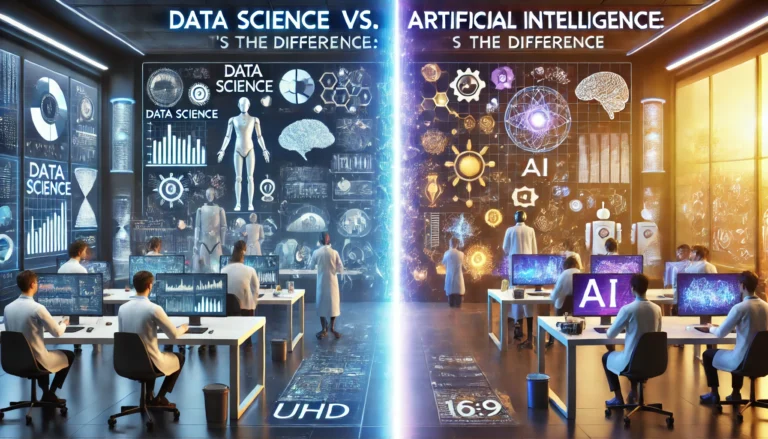
Artificial Intelligence (AI) is revolutionizing how we interact with technology, solve problems, and understand the world. From virtual assistants like Siri to autonomous vehicles, AI powers many modern innovations. But what exactly is AI? In this beginner’s guide, we break it down to help you understand the basics.
Table of Contents
- Introduction to Artificial Intelligence
- History of AI Development
- Types of AI
- How Does AI Work?
- Applications of AI in Everyday Life
- Benefits of Artificial Intelligence
- Challenges and Ethical Concerns
- The Future of AI
- Learning AI: Where to Start?
- Conclusion
1. Introduction to Artificial Intelligence
Artificial Intelligence refers to machines or systems that simulate human intelligence. These AI systems can think, reason, learn, and solve problems. From language comprehension to visual perception, AI enables machines to perform tasks that typically require human cognitive abilities.
AI is not just about robots or futuristic gadgets—it’s about automating tasks, improving efficiency, and creating systems that can learn and adapt over time.
2. History of AI Development
AI’s origins can be traced back to ancient mythology, but it became a formal field of study in the 20th century. Here’s a brief look at its evolution:
- 1940s-1950s: Pioneers like Alan Turing laid the groundwork for AI concepts.
- 1956: The term “Artificial Intelligence” was coined during the Dartmouth Conference.
- 1980s: The rise of expert systems that used rule-based logic for decision-making.
- 2000s onwards: Machine learning and neural networks revolutionized AI, enabling complex tasks like image recognition and natural language processing.
3. Types of AI
AI can be categorized into two main types based on capability and functionality:
Based on Capability:
- Narrow AI: Specialized in specific tasks (e.g., Siri, recommendation engines).
- General AI: Hypothetical AI that can perform any intellectual task like a human.
- Super AI: Theoretical AI that surpasses human intelligence.
Based on Functionality:
- Reactive Machines: Basic AI systems (e.g., IBM’s Deep Blue).
- Limited Memory: AI that uses past data for decision-making (e.g., self-driving cars).
- Theory of Mind: Still in development; aims to understand human emotions and social interactions.
- Self-Aware AI: Hypothetical AI with consciousness and self-awareness.
4. How Does AI Work?
AI systems rely on advanced algorithms, massive data processing, and computational power to function. Here’s an overview of how AI works:
- Data Collection: AI systems gather and analyze large datasets.
- Machine Learning: AI models learn from data using techniques like supervised and unsupervised learning.
- Neural Networks: Modeled after the human brain, neural networks help AI solve complex problems.
- Natural Language Processing (NLP): Enables AI systems to understand and generate human language.
- Computer Vision: Allows AI to interpret and analyze visual data like images and videos.
5. Applications of AI in Everyday Life
AI is already integrated into many aspects of our daily lives. Some key applications include:
- Healthcare: AI assists in disease diagnosis, robotic surgeries, and personalized treatment plans.
- Finance: AI helps detect fraud, optimize trading, and automate customer service through chatbots.
- Transportation: AI powers autonomous vehicles and traffic management systems.
- Retail: AI enhances recommendation engines, inventory management, and customer service.
- Education: AI is used in adaptive learning platforms and virtual tutors to provide personalized education.
6. Benefits of Artificial Intelligence
AI offers several advantages, including:
- Automation: Streamlines repetitive tasks, saving time and effort.
- Efficiency: Increases productivity and reduces human error.
- Innovation: Drives breakthroughs in various industries.
- Accessibility: Makes resources like healthcare and education more widely available.
7. Challenges and Ethical Concerns
As AI continues to evolve, several challenges and ethical concerns need to be addressed:
- Data Privacy: Protecting user data and ensuring privacy.
- Bias and Fairness: Ensuring AI systems make unbiased decisions.
- Job Displacement: Addressing the potential loss of jobs due to automation.
- Ethical Dilemmas: Defining the boundaries of AI applications, such as surveillance or military use.
8. The Future of AI
AI is expected to grow exponentially, with exciting developments in the following areas:
- Quantum Computing: Solving complex problems that are currently beyond classical computing.
- AI in Space Exploration: Assisting in interplanetary missions.
- Personalized AI: Tailored experiences in healthcare, education, and entertainment.
9. Learning AI: Where to Start?
If you’re interested in learning AI, here’s a roadmap:
- Beginner Courses: Platforms like Coursera and Udemy offer beginner-friendly AI courses.
- Programming Skills: Learn Python, a key programming language for AI.
- Books and Blogs: Read foundational resources like Artificial Intelligence: A Modern Approach.
- Hands-on Practice: Experiment with AI frameworks like TensorFlow and PyTorch.
10. Conclusion
Artificial Intelligence is shaping the future of technology, offering incredible opportunities alongside challenges. Understanding its fundamentals is the first step toward exploring and contributing to this transformative field.
Whether you’re a student, professional, or enthusiast, diving into AI opens up endless possibilities.
Read more Articles
You Should Know the Differences Between AI, Machine Learning, and Deep Learning




